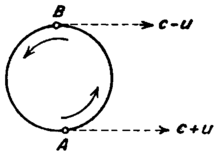De Sitter double star experiment
The de Sitter effect was described by Willem de Sitter in 1913[1][2][3][4] (as well as by Daniel Frost Comstock in 1910[5]) and used to support the special theory of relativity against a competing 1908 emission theory by Walter Ritz that postulated a variable speed of light. De Sitter showed that Ritz's theory predicted that the orbits of binary stars would appear more eccentric than consistent with experiment and with the laws of mechanics, however, the experimental result was negative. This was confirmed by Brecher in 1977 by observing the x-rays spectrum.[6] For other experiments related to special relativity, see tests of special relativity.
The effect


According to simple emission theory, light thrown off by an object should move at a speed of  with respect to the emitting object. If there are no complicating dragging effects, the light would then be expected to move at this same speed until it eventually reached an observer. For an object moving directly towards (or away from) the observer at
with respect to the emitting object. If there are no complicating dragging effects, the light would then be expected to move at this same speed until it eventually reached an observer. For an object moving directly towards (or away from) the observer at  metres per second, this light would then be expected to still be travelling at
metres per second, this light would then be expected to still be travelling at  ( or
( or  ) metres per second at the time it reached us.
) metres per second at the time it reached us.
In 1913, Willem de Sitter argued that if this was true, a star in a double-star system would usually have an orbit that caused it to have alternating approach and recession velocities, and light emitted from different parts of the orbital path would then travel towards us at different speeds. For a nearby star with a small orbital velocity (or whose orbital plane was almost perpendicular to our line of view) this might merely make the star's orbit seem erratic, but for a sufficient combination of orbital speed and distance (and inclination), the "fast" light given off during approach would be able to catch up with and even overtake "slow" light emitted earlier during a recessional part of the star's orbit, and the star would present an image that was scrambled and out of sequence. That is, Kepler's laws of motion would apparently be violated for a distant observer.
De Sitter made a study of double stars and found no cases where the stars' computed orbits appeared non-Keplerian. Since the total flight-time difference between "fast" and "slow" lightsignals would be expected to scale linearly with distance in simple emission theory, and the study would (statistically) have included stars with a reasonable spread of distances and orbital speeds and orientations, deSitter concluded that the effect should have been seen if the model was correct, and its absence meant that the emission theory was almost certainly wrong.
Notes
- Modern experiments of the De Sitter type refute the idea that light might travel at a speed that was partially dependent on the velocity of the emitter (c'=c + kv), where the emitter's velocity v can be positive or negative, and k is a factor between 0 and 1, denoting the extent to which the speed of light depends on the source velocity. De Sitter established an upper limit of k < 0.002, but extinction effects make that result suspect.[4]
- De Sitter's experiment was criticized because of extinction effects by J. G. Fox. That is, during their flight to Earth, the light rays would have been absorbed and re-emitted by interstellar matter nearly at rest relative to Earth, so that the speed of light should become constant with respect to Earth, regardless of the motion of the original source(s).[8] In 1977, Kenneth Brecher published the results of a similar double-survey, and reached a similar conclusion - that any apparent irregularities in double-star orbits were too small to support the emission theory. Contrary to De Sitter, he observed the x-ray spectrum, thereby eliminating possible influences of the extinction effect. He established an upper limit of
 .[6]
.[6]
- There are also terrestrial experiments that speak against such theories, see experiments testing emission theories.
References
- ↑ W. de Sitter, Ein astronomischer Beweis für die Konstanz der Lichgeshwindigkeit Physik. Zeitschr, 14, 429 (1913).
- ↑ W. de Sitter, Über die Genauigkeit, innerhalb welcher die Unabhängigkeit der Lichtgeschwindigkeit von der Bewegung der Quelle behauptet werden kann Physik. Zeitschr, 14, 1267 (1913).
- ↑ De Sitter, Willem (1913), "A proof of the constancy of the velocity of light", Proceedings of the Royal Netherlands Academy of Arts and Sciences 15 (2): 1297–1298
- ↑ 4.0 4.1 De Sitter, Willem (1913), "On the constancy of the velocity of light", Proceedings of the Royal Netherlands Academy of Arts and Sciences 16 (1): 395–396
- ↑ Comstock, Daniel Frost (1910), "A Neglected Type of Relativity", Physical Review 30 (2): 267, doi:10.1103/PhysRevSeriesI.30.262
- ↑ 6.0 6.1 Brecher, K. (1977). "Is the speed of light independent of the velocity of the source". Physical Review Letters 39 (17): 1051–1054. Bibcode:1977PhRvL..39.1051B. doi:10.1103/PhysRevLett.39.1051.
- ↑ Bergmann, Peter (1976). Introduction to the Theory of Relativity. Dover Publications, Inc. pp. 19–20. ISBN 0-486-63282-2.
In some cases, we should observe the same component of the double star system simultaneously at different places, and these 'ghost stars' would disappear and reappear in the course of their periodic motions.
- ↑ Fox, J. G. (1965), "Evidence Against Emission Theories", American Journal of Physics 33 (1): 1–17, Bibcode:1965AmJPh..33....1F, doi:10.1119/1.1971219.
| ||||||||||||||||||||||||||||||